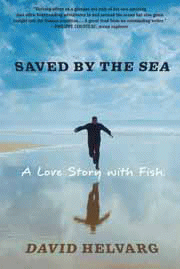SEJournal Online is the digital news magazine of the Society of Environmental Journalists. Learn more about SEJournal Online, including submission, subscription and advertising information.

BookShelf
Saved by the Sea: A Love Story with Fish
By David Helvarg
Thomas Dunne Books, $25.99
Reviewed by KATHLEEN REGAN
In Saved by the Sea, David Helvarg has told a beautiful, sad, wonderful and hard story. Its centerpiece is the loss of loved ones — his life partner, his sister, his mother and father. But the book is not just about loss, it is also about how his viscerally deep love and knowledge of the ocean comforted him, accompanied him and strengthened him through those losses. The deeper story is that of how Helvarg resists the idea of a random, meaningless world. Instead, in the best tradition of what it is to be human, he transforms his experiences of loss into the service of his love for the sea. Along the way we learn a great deal about the ocean and possibly something about humanity.
Our need to make meaning out of our experience is essential to human nature. We tell stories — to ourselves, to others — to transform random and unpredictable events into narrative because not to do so would leave us at the mercy of an incomprehensible universe over which we have no power. Telling stories, transforming our experience, is our power. Good stories, compelling stories, are both intellectually honest and emotionally engaging. This one is both.
One of the book's challenges is its shifting between Helvarg's life experiences and his commentary on the sea. Every now and then this seems a little awkward, but for the most part his voice is sure. In fact, the deeper one gets into the book, the clearer it is that his love of the sea is its own real love story, just as emotionally compelling as the human relationships he describes. Emotional connections to our world can be a much stronger force for action than technical sophistication. The greatest strength of Saved by the Sea is how well it exemplifies the power of emotion coupled with understanding and reveals the bonds of love and affection that illuminate our connection to the physical world. A second challenge is that the book deals with substantive and emotionally heavy issues. Sometimes it seemed Helvarg could have provided more detail or moved more slowly through his story. As a reader, I wanted more time to digest what was happening in his life, more information in order to understand particular events and more opportunity to reflect more deeply on what I was being told. she understood her reactions to the problem of environmental degradation, that a better kind of question would be, "What are the things in this world that you love? Who are the primary caretakers of beauty and of the things you love? What are the obstacles to your becoming more engaged?"
Helvarg's transformation of his own experience, and his generosity in sharing it with us, can serve as a beacon for anyone who reads it. What do we love? What are the physical things that move us? Each of us has some experience of the physical world that touches us more deeply than we can understand. Helvarg gives us a way, through his example, to harness the strength of that emotional connection in the service of protecting some part of our world. And I suspect this may, in the end, be the only way the world will be protected.
Kathleen Regan is currently a mid-life PhD student in soil biology at the University of Hohenheim, Germany, working on the question of nitrogen cycling and nitrous oxide emissions from soil.
* From SEJ's quarterly newsletter SEJournal, Summer, 2010 issue.













 Advertisement
Advertisement 



